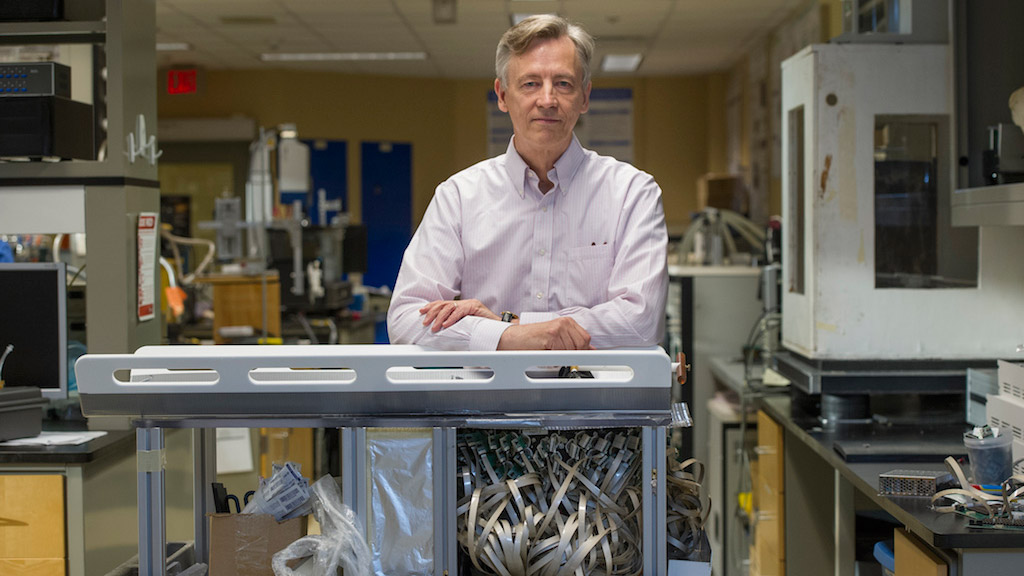A fitting distinction
Dr. Kullervo Hynynen, director of Physical Sciences at Sunnybrook Research Institute (SRI), has received many accolades throughout his illustrious career. Now he can add one more title to his already impressive CV: Fellow of the IEEE (Institute of Electrical and Electronics Engineers, pronounced “eye-triple-E”).
The highly selective honour, which is given to no more than 0.1% of the total IEEE voting membership, is reserved for those with an extraordinary record of accomplishments. The organization noted that Hynynen was chosen for his “contributions to image-guided therapeutic focused ultrasound.” The technology uses the energy from sound waves to effect a biological change in tissue, like destroying a lesion, as in high-intensity focused ultrasound, and opening the blood-brain barrier, as in low-intensity focused ultrasound.
“For more than three decades Kullervo has taken ultrasound devices all the way from ideas to technologies that are used on patients, overcoming significant technical challenges to do so. He is the “oracle” in this field. I’m delighted, but not surprised, to see him recognized with this honour,” says Dr. Michael Julius, vice-president, research, Sunnybrook Health Sciences Centre and SRI.
Looking back on his career Hynynen says, “Focused ultrasound is a disruptive technology. It has the potential to transform the way diseases are treated. It has been extremely gratifying to see our research move from the lab to the clinic. I am deeply honoured for this recognition from the IEEE, which would not have been possible without the contributions of many students, colleagues and lab members.”
Under Hynynen’s leadership, researchers at SRI have made groundbreaking advances in focused ultrasound, from discovery science, to technology development to clinical studies. In 2015, Hynynen was lead physicist of a team at Sunnybrook that was the world’s first to deliver chemotherapy into the brain of a woman with brain cancer noninvasively. In 2017, under Hynynen’s scientific leadership, Sunnybrook researchers conducted the world’s first clinical trial using focused ultrasound to cross the blood-brain barrier in people with Alzheimer’s disease.
His career is marked by one breakthrough after another. In 2001, Hynynen’s lab was the first to show that focused ultrasound paired with microbubbles could locally and temporarily disrupt the blood-brain barrier. Years later, he and Dr. Isabelle Aubert, a neurobiologist at SRI, were the first to deliver stem cells and gene therapy into the brain preclinically using MRI-guided focused ultrasound. They went on to show that MRI-guided focused ultrasound alone reduces brain plaque in mice with Alzheimer’s disease.
Discoveries he made on focused ultrasound for tissue ablation with colleagues in research and industry led to the formation of a company, InSightec, which commercialized the technology. The system, which pairs high-intensity focused ultrasound with MRI to guide and monitor delivery, is approved for use in the U.S. for uterine fibroids, growths that can cause excessive menstrual bleeding and pain. One treatment for uterine fibroids is hysterectomy, a procedure that renders a woman infertile, has risks of complications and involves a long recovery. Focused ultrasound, by contrast, is noninvasive, spares fertility and allows women to return to their lifestyles within a day.
In August 2016, the U.S. Food and Drug Administration and Health Canada approved InSightec’s brain device for treatment of essential tremor, a movement disorder that afflicts about half a million Canadians. They did so on the back of a seminal clinical trial showing that focused ultrasound safely and effectively reduces tremor in people for whom nothing else had worked.
Eleven other Canadian members of the IEEE were elevated to the grade of Fellow in January 2018. The organization’s membership, more than 423,000 strong, is comprised of engineers, physicists, computer scientists, medical doctors and information technology professionals, among others.






